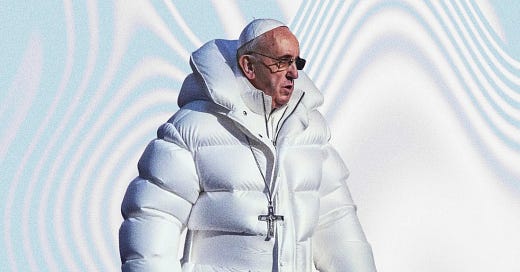AI, Art, and the Elusive Concept of Authenticity
Will AI proliferation downplay the societal role of creativity and artistic authenticity?
viral AI image of the Pope generated by Midjourney. Collage: Gabe Conte
In our tech-driven world, it appears that AI has its influence on almost everything. The creative industry is not exempt from this dominance, with AI having the capability to generate images, auto-edit and airbrush photographs, produce music, and write essays in seconds. On an individual level, the presence of AI art can allow us affordability when working on projects. For example, instead of paying for graphics, I could use DALL·E 3 to create an image, saving me both time and money. On a more significant societal level, this could negatively affect the creative economy through using well-trained AI systems to replace creative human labor. Additionally, the authenticity factor of art and creativity can be grossly undermined when machines consistently churn out work based on their trained algorithms.
On Authenticity
The concept of “authenticity” has long been debated within creative and artistic spaces. In college, I had a professor who forbade us from using the word “authentic” to describe a work of art. She claimed it was a cop-out phrase, and far better direct and descriptive terminologies existed to categorize art. The dictionary meaning of “authenticity” is the quality of something being real or true. Not to delve too deeply into the philosophical semantics, but it is challenging to decide what is real, what is not, and what is true and what is not, because what basis are we choosing this from? What is the universal ‘true north’?
One of the myriad ways of looking at artistic authenticity is originality, which stands on its own and is not a replica. The creative landscape has transformed over time, and replicability is nothing new. People have created art inspired by or directly replicated from pre-existing works for centuries. As time has elapsed, art has become increasingly easy to reproduce on a mass scale. German philosopher and cultural critic Walter Benjamin, in his landmark essay, “The Work of Art in the Age of Mechanical Reproduction,” delves into the effect of artistic reproducibility on authenticity by stating that “even the most perfect reproduction of a work of art is lacking in one element: its presence in time and space, its unique existence at the place where it happens to be.”
Benjamin hints at the fact that each original work carries with it its own aura, distinct from even its best replication. While his work, situated in the 1940s, was primarily referring to cameras and print media that allowed people to capture and print photographs, his teachings remain relevant to date. To explore the relationship between authenticity and reproducibility, it is crucial to understand how these AI algorithms that generate images and music are trained.
On Algorithmic Training
Most algorithms that produce images and music are trained using Generative Adversarial Networks (GANs). GANs are a type of deep-learning algorithm that enables computers to generate new, artificial data based on existing data sets that they were trained on. There are two neural networks in GANs:
1. Generator: Generates new images based on the training data fed to it
2. Discriminator: Chooses between real and fake images
The generating and discrimination is an iterative process of fine-tuning until the discriminator cannot differentiate between real and fake images, hence the creation of ultra-realistic AI-generated images.
image by Geeks for Geeks showcasing how GANs work
In this way, all AI-generated art is a replica of existing art. The algorithm may choose to combine aspects of different art pieces to generate new images. However, at its core, all products of AI art are massively reproduced and lacking in “authenticity.”
On Ownership
The question of authenticity and originality brings to the fore the issue of copyright and ownership. With AI-generated art, who can claim ownership of a particular work? For example, if I, as a prompt engineer, ask an AI model to generate a self-portrait in Basquiat’s signature style, does the work belong to me, to the AI’s parent company, or to Basquiat, whose work was used to train the model?
Currently, copyright laws in the US and the EU forbid the copyrighting of AI-generated art, thereby centralizing human creativity as the standard for ownership. Additionally, the EU passed the AI Act for AI regulation that states within its transparency clause that Generative AI must publish summaries of copyrighted data used for training.
AI-generated Art Within Society
Perceptions of the use of AI in creative endeavors vary because art serves different purposes in society. For lots of consumers, generating images of themselves using AI is a creative act in and of itself. AI art allows people to imagine themselves in novel ways. It allows for child-like playfulness and creativity, e.g., inputting your image into an AI image generator like ImagineMe, and it creates a futuristic vision of you as the queen of a tribal kingdom.
On the other hand, as generative AI becomes more sophisticated, it can easily be used to wipe out thousands of jobs, especially writing ones. In fact, the Hollywood writer’s protest by the Writer’s Guild of America (WGA) had AI as one of its central concerns. Writers were concerned that unregulated AI could unfairly pit them against machines in a productivity battle they were bound to lose. The agreement was that AI could be used by the writers to augment their writing process but not by their bosses to replace their labor.
Conclusively, as AI-generated art (visual art, music, writing) spreads, issues of authenticity, ownership, and job replacement will continue to creep up. While there is existing policy infrastructure safeguarding ownership, the same cannot be said for adequate measures addressing the potential impact on employment. It is imperative to prioritize the human dimension of job protection within these advancements.





